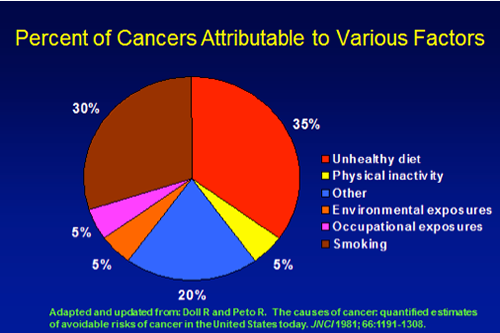Online Course
NRSG 780 - Health Promotion and Population Health
Module 10: Leading Causes of Morbidity and Mortality
Cancer -- Magnitude of the Problem and Prevention
Magnitude of the Problem
Cancer is the second leading cause of death in the United States. In 2025, over 2 million new cases of cancer will be detected, about 618,000 people are expected to die from cancer, almost 1700 per day. The National Cancer Institute reports that cancer-related medical costs in the US were $208.9 billion in 2020 and considers this an underestimate because it does not include the escalating costs of new treatments and does not include the cost due to lost productivity from morbidity and premature mortality. Men have a slightly higher chance of developing cancer than women. Cancer is caused by both external factors such as tobacco, infectious organisms, radiation and chemical exposure and internal factors such as inherited mutations, hormones, immune conditions and metabolic mutations. The American Cancer Society estimates that at least 40% of cancers could be prevented.

How Information on Cancer Across the Nation Is Obtained
Medical facilities such as hospitals, doctor's offices, and pathology laboratories send information about cancer cases to their cancer registry. Most information comes from hospitals, where highly trained cancer registrars transfer the information from the patient's medical record to the registry's computer software using standardized codes. The data on diagnosis, follow-up, treatment and survival are then sent to a central cancer registry, a population-based resource for examining cancer patterns. The first central cancer registry was established in Connecticut in 1935. Many states developed similar programs soon afterwards. However, it was not until the National Program of Cancer Registries (NPCR) was established by Congress through the Cancer Registries Amendment Act in 1992 that all states began collecting data on cancer occurrence (type, extent, and location) and the type of initial treatment. The NPCR is administered by CDC.
Together, CDC's NPCR and the National Cancer Institute's (NCI's) Surveillance, Epidemiology and End Results (SEER) Program collect incidence data for the entire U.S. population. CDC's National Center for Health Statistics' National Vital Statistics System collects mortality data. This national coverage enables researchers, clinicians, policy makers, public health professionals, and members of the public to monitor the burden of cancer, evaluate the success of programs, and identify additional needs for cancer prevention and control efforts at national, state, and local levels.
Cancer registry data are used to:
- Monitor cancer trends over time
- Show cancer patterns in various populations and identify high-risk groups
- Guide planning and evaluation of cancer control programs
- Help set priorities for allocating health resources
- Advance clinical, epidemiologic and health services research.
Prevention
According to the National Cancer Institute, 80% of cancers are due to factors that have been identified and can potentially be controlled. Not only can we potentially prevent most cancers, we can also improve the survival rates of those people who have cancer.

A substantial proportion of cancers can be prevented through risk reduction strategies:
- Avoid Tobacco
- Cigarette smoking
- Cigar smoking
- Smokeless tobacco
- Secondhand smoke
Click here for more information on tobacco and review pages 30-31.
- Maintain a healthy weight
- Consume a healthy diet with emphasis on plant food
- Limit alcohol
- Adopt a physically active lifestyle
Click here for more information and review pages 31-32.
- Ultraviolet light
- Infectious agents including HPV, Hepatitis B and C and HIV
- Medical treatments
- Carcinogens that exist as pollutants
- Naturally occurring and occupational carcinogens
Click here to review NCI’s Cancer Prevention Overview Description of the Evidence
The number of new cancer cases can be reduced through minimizing risk exposure; many cancer deaths can be prevented through early detection. Screening is becoming more accessible for many cancers, and together with health education and referral services, plays a key role in reduce cancer incidence and deaths. The Affordable Care Act eliminates deductibles for many types of screening and CDC offers free or low-cost mammograms and Pap tests nationwide and free or low-cost colorectal cancer screening - through 24 state health departments, six universities and one American Indian tribe.
This website is maintained by the University of Maryland School of Nursing (UMSON) Office of Learning Technologies. The UMSON logo and all other contents of this website are the sole property of UMSON and may not be used for any purpose without prior written consent. Links to other websites do not constitute or imply an endorsement of those sites, their content, or their products and services. Please send comments, corrections, and link improvements to nrsonline@umaryland.edu.